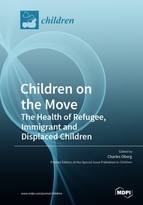Children on the Move: The Health of Refugee, Immigrant and Displaced Children
A special issue of Children (ISSN 2227-9067). This special issue belongs to the section "Global and Public Health".
Deadline for manuscript submissions: closed (1 September 2019) | Viewed by 88336
Special Issue Editor
Special Issue Information
Dear Colleagues,
This Special Issue of Children will focus on the health impact on children experiencing migration as refugees, immigrants, and those internally displaced within their own country due to war and conflict. Topics to be explored will include, but will not be limited to, the epidemiology of displacement, adverse health conditions, trauma and mental health, best practices and care corrdination. We will also explore specific populations such as children with disabilites, unaccompanied minors and child separation at international borders. The Special Issue will conclude with a examination of new clinical guidelines, the development of new care systems and the advocacy for new policies addressing these children in need.
Prof. Charles N. Oberg
Guest Editor
Manuscript Submission Information
Manuscripts should be submitted online at www.mdpi.com by registering and logging in to this website. Once you are registered, click here to go to the submission form. Manuscripts can be submitted until the deadline. All submissions that pass pre-check are peer-reviewed. Accepted papers will be published continuously in the journal (as soon as accepted) and will be listed together on the special issue website. Research articles, review articles as well as short communications are invited. For planned papers, a title and short abstract (about 100 words) can be sent to the Editorial Office for announcement on this website.
Submitted manuscripts should not have been published previously, nor be under consideration for publication elsewhere (except conference proceedings papers). All manuscripts are thoroughly refereed through a single-blind peer-review process. A guide for authors and other relevant information for submission of manuscripts is available on the Instructions for Authors page. Children is an international peer-reviewed open access monthly journal published by MDPI.
Please visit the Instructions for Authors page before submitting a manuscript. The Article Processing Charge (APC) for publication in this open access journal is 2400 CHF (Swiss Francs). Submitted papers should be well formatted and use good English. Authors may use MDPI's English editing service prior to publication or during author revisions.
Keywords
- refugee
- immigrant
- internally displaced
- trauma-informed care
- care coordination
- mental health







